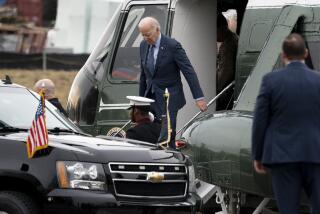Clinton to Get Hearing Aids for Both Ears
- Share via
WASHINGTON — In a sign of his advancing age--as well as too many hours of band practice in his youth--President Clinton was fitted Friday with hearing aids for both ears, his physicians announced.
The news that Clinton’s high-frequency hearing deficiency, a longtime medical problem for him, has worsened to the point that he needs hearing aids was seen by some as emblematic of the maturing of the first baby boomer president, and of his generation.
“Boomers are not youthful anymore, and boomers have to accept that,” said William Strauss, an author who specializes in generational trends and issues. “Boomers are the midlife generation right now.”
The decision to provide Clinton, 51, with hearing aids was made during his annual physical at Bethesda Naval Hospital.
After the six-hour physical, doctors also reported that the 6-foot-2 president had worked off 20 pounds since his last physical examination in May 1996, and he has reduced his cholesterol count from 191 to 179. Doctors generally consider cholesterol counts below 200 in the desirable range.
The president attributed his weight loss to the physical training regime and changes in diet that he embraced after suffering a knee injury in the spring, White House spokesman Mike McCurry said. Most people gain weight after such an injury, but Clinton had said that he was determined not to do so.
Although the president sometimes complains of stiffness in his knee, his orthopedic surgeon declared him fully recovered from the tear of his quadriceps tendon.
During the course of the examination, the president also ran on a treadmill for 13 minutes and had a small cyst removed from the left side of his chest.
Dr. David Corbett, one of the team of doctors examining Clinton, likened the cyst to one removed last year from the president’s neck and found to be benign. Corbett said that he would “be amazed” if the new cyst proved anything but benign when a pathology report comes back from the lab Monday.
But the big news of the day was the hearing aids.
Clinton will only wear the small, high-tech devices on select occasions, particularly in gatherings where there is background noise, said Dr. James Suen, the hearing specialist who treated the president. The “completely-in-canal” hearing aid sits inside the auditory canal, where it will be barely visible.
“It’s just a moderate-severe [hearing loss],” said Suen. “It interferes with his understanding of certain words. It’s not anything like profound deafness.”
Suen attributed the hearing loss, which has grown only slightly worse over the last two years, to Clinton’s age and the band-playing days of his youth.
McCurry said that the president has complained on occasion of difficulty hearing, particularly in crowded rooms.
About 5% of Americans the president’s age experience similar hearing problems, according to Dr. Akira Ishiyama, assistant professor of otology at UCLA.
And news of Clinton’s hearing loss, according to experts on baby boomer trends, is certain to accelerate a growing awareness of the problem in this generation. Like Clinton, the leading edge of the boomer generation is reaching an age when hearing loss is first likely to become evident.
Workplaces, once the leading culprit of hearing loss, have become safer because of regulatory efforts. But many members of the estimated 77 million in the “Woodstock generation” are also finding that they are feeling the effects of having listened to and played rock ‘n’ roll at ear-splitting volumes.
Today, onetime membership in a garage band has surpassed occupational exposure to noise as a cause of hearing loss, said Dick Brandt, spokesman for the Minnesota-based firm that manufactures Miracle-Ear hearing aids.
Carole Rogin, president of the Hearing Industry Assn., praised the president for opting to get hearing aids and make that fact public. “Clinton’s openness will help millions of Americans who can also benefit from hearing aids,” she said.
Indeed, marketing analysts believe that baby boomers--as exemplified by Clinton’s willingness to wear hearing aids--are more willing to accept the use of hearing aids. That, they said, is partly because there will be so many boomers needing hearing aids and partly because it has not been their way to let such an affliction limit their participation in life.
“For people in their 70s and older, there’s a stigma attached to hearing aids. It’s like having one foot in the grave, it’s such an issue of mortality,” said Barbara Tannenbaum, managing editor of Age Wave Communication, which publishes the Boomer Report. “I don’t think that’s going to be such an issue for baby boomers. We’re into longevity, we’re into our health and enjoyment of life. We’re going to demand that manufacturers go about this a little differently, though, because we demand a new style, a new aesthetic. It’s going to be cool-looking--we’re going to have a video feed!”
Times staff writer Melissa Healy contributed to this story.
(BEGIN TEXT OF INFOBOX / INFOGRAPHIC)
Clinton’s Hearing
President Clinton, who turned 51 in August, has complained for years about hearing loss, listing it as a problem in his annual physicals since his days as Arkansas’ governor.
Doctors recommended a “completely-in-canal” device.
This type of Device is . . .
* Fitted from impression of the ear canal
* Invisible from face on.
* Battery operated.
* Approximately 1 inch long
* Fits the entire length of the ear canal.
Sources: UCLA, American Speech-Language-Hearing Assn.
Researched by D’JAMILA SALEM FITZGERALD and REBECCA PERRY / Los Angeles Times
More to Read
Sign up for Essential California
The most important California stories and recommendations in your inbox every morning.
You may occasionally receive promotional content from the Los Angeles Times.












